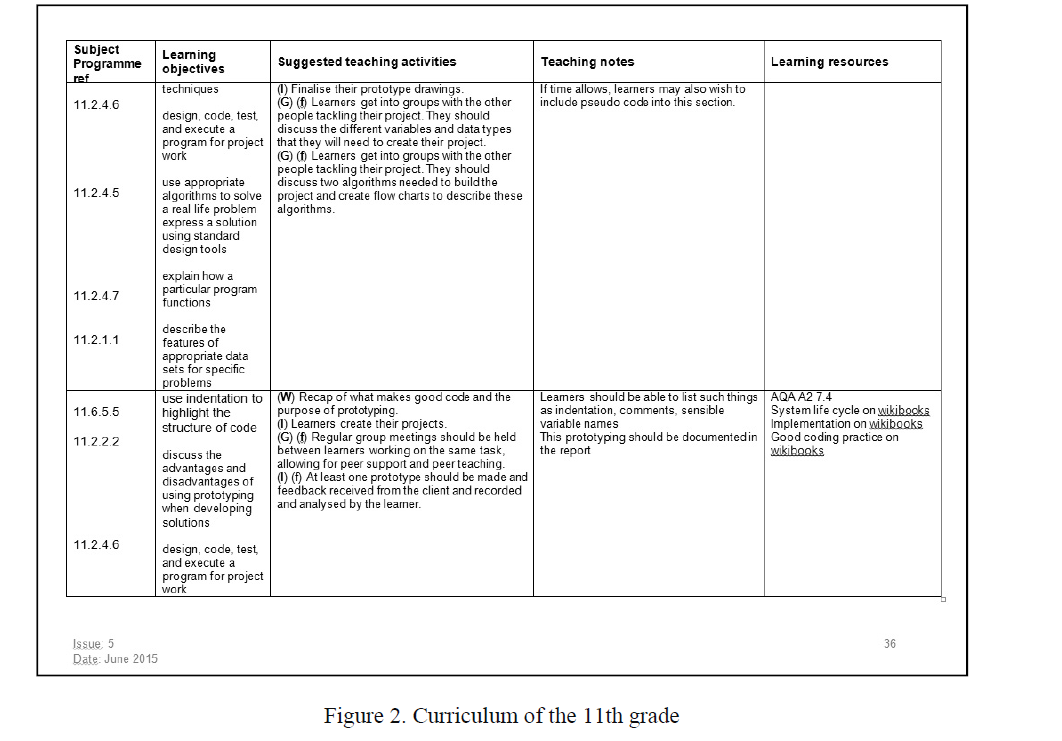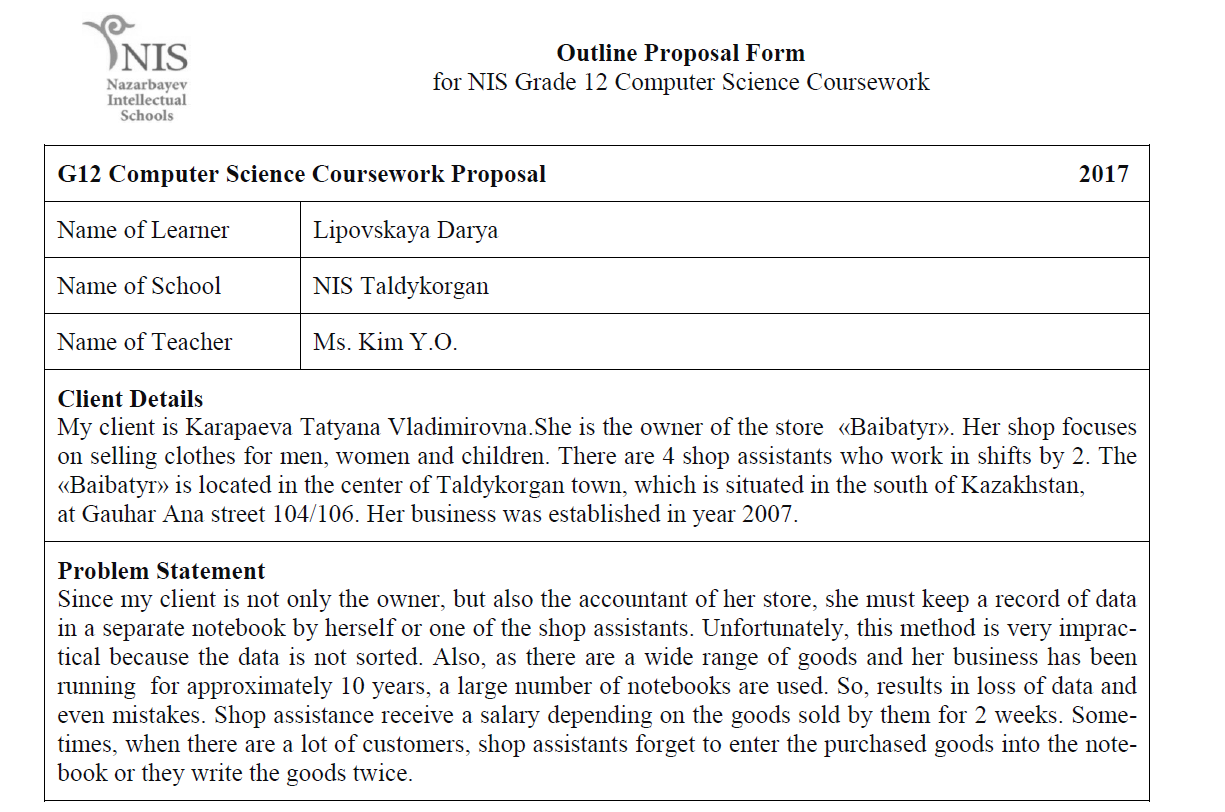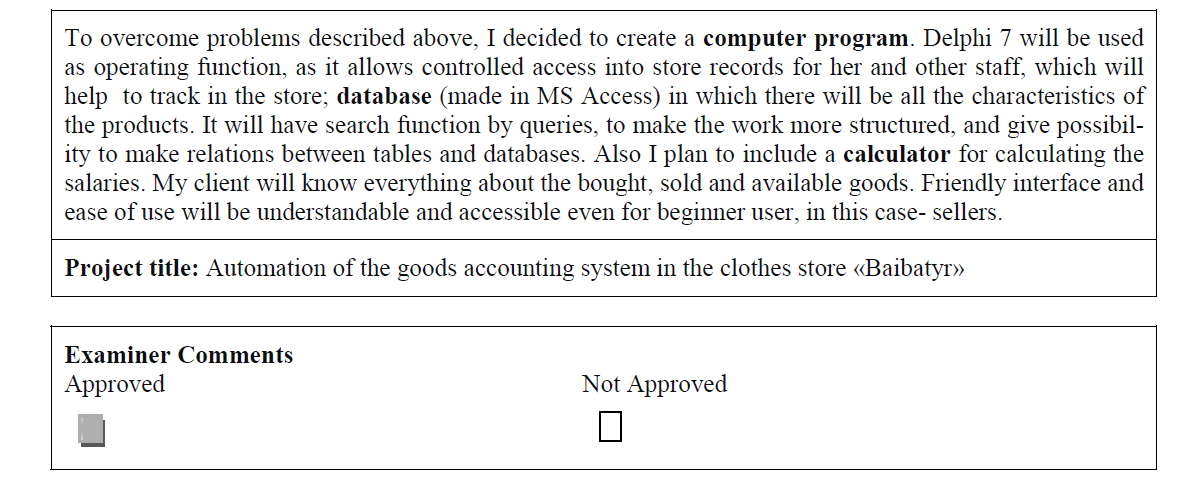In 11 classes, in-depth study of subjects «Informatics», «Global perspectives» is expected. Throughout the course, the students carry out project work, therefore using different authors to develop research skills. The article demonstrates the personal experience of authors in writing projects and applying new approaches to teaching that contribute to the achievement of the goal. Authors cite fragments of the curriculum, a guide to writing a course work on the subject «Informatics», topics approving forms , an example of a lesson with elements of pedagogical tools and methods. Analyzing the feedback from the NIS alumni, they conclude that writing essays and course work develops students' high-level skills such as; critical thinking, analysis and assessment. Also, the obtained school experience helps in writing similar works in higher educational institutions. Students acquire competitive skills, unorthodox thinking and active personalities. The study of the subject «Global perspectives» makes the younger generation think about questions in different social spheres. In addition, the authors note that some projects are used in everyday life and give an example as evidence.
In modern society, there is a growing need for people who are unconventional, active, creative, capable of solving the set goals and tasks unconventionally. Therefore, now the issue of creating conditions for improving the quality of the educational process is widely discussed in education. In the arsenal of innovative pedagogical tools and methods, a special place is occupied by educational research.
Research is one of the most important ways to solve this problem. Such activities, which place students in the position of «researcher», take a leading place in modern systems of developmental education.
Educational research activity is a specially organized, cognitive creative activity of students characterized by purposefulness, activity, objectivity, motivation and consciousness, the result of which is the formation of cognitive motives, research skills, subjectively new to students knowledge and modes of activity.
To develop students' research skills, the teacher needs the creation of such conditions that would meet the stated goal:
- Purposeful and systematic: Work to develop research skills should take place both in the classroom and in after-hours
- Motivation: Students should see the meaning of their creative independent activity so that they can realize their talents, abilities and
- Accounting for age characteristics: Research should be feasible, interesting, exciting and useful. All stages of research work should be based on the level available to the junior
- Psychological comfort. The teacher should give each child the opportunity to believe in himself, to showcase their best qualities, to support, if something does not work, help and
- Personality of the teacher: In order for research to be effective, a highly educated teacher needs to be creative about his work, striving for a new, progressive
- Creative environment: The teacher helps create a creative, working atmosphere. Teaching students to research is designed to ensure the following:
- the possibility of mastering research methods and their use in studying topics of any subjects of the school course;
- the possibility of developing interests in certain school disciplines and the process of cognition of the surrounding world and reality as a whole;
- the possibility of applying the acquired knowledge and skills in the implementation of their own ideas and
Any research work consists of several stages.
- raising the problem (or highlighting the underlying issue),
- studying the theory associated with the chosen problem, the degree of its study;
- the hypothesis of research,
- selection of techniques and practical mastery of them,
- collection of own material,
- its analysis and generalization,
- own conclusions,
- Presentation of the completed research in the selected (required, standard)
In Nazarbayev intellectual schools much attention is paid to the development of high-level skills, namely critical thinking, analysis and synthesis. For each subject, the curriculum pays much attention to research activities, as an instrument for developing the above skills. For example, in the subjects «Informatics», «Global perspectives» in each quarter there is a section «Project activity», which presumes the writing of a mini-project with observance of all stages of project development. In addition, high school students who have chosen computer science for in-depth study, take the final external evaluation, consisting of three components. The first component is the testing of knowledge and understanding skills, the second is a skill test application and the third component is writing a course work for the development of high-level skills. It should be noted that from the next academic year it is supposed to teach the subject in English. Also on the subject «Global Perspectives» 11th grade students prepare a social project.
Questions arise, how can students do a great job without having the experience and extra time? To what extent is this work practical? What is the advantage of doing this job? In this article we will try to answer these questions.
The writing of the course work is a lengthy process, for two years students of 11 grade are engaged in research activities in the lessons assigned to the project activity (Fig. 1).

Figure 1. Curriculum of the 11th grade
In the framework of the curriculum in the 11th grade, the following goals are expected to be achieved (Figure 2): name and explain the steps and justify conclusions drawn from data analysis; Understand what prototyping is, solve a real life problem by applying appropriate problem-solving techniques; Design, code, test, and execute a program for project work; Use appropriate algorithms to solve a real life problem; Express a solution using standard; Design tools; Explain how a particular program functions; Describe the features of the appropriate data sets for specific problems; Use indentation to highlight the structure of the code, discuss the advantages and disadvantages of using prototyping when developing solutions [1].

Figure 2. Curriculum of the 11th grade
The fundamental document when writing a work is a manual that reflects all stages of the life cycle of the information system, and evaluation criteria [2; 10-14].
|
(d) Software development, programming testing and installation 18 marks |
(i) Development 4 marks |
Program listings or evidence of tailoring of a software package is provided in the form of printouts. The developed solution does not fulfil the design specification. A teacher may award 1 mark if they have been shown the system working satisfactorily and there is no hard evidence in the project report. |
1 |
|
Program listings or evidence of tailored software packages are provided in the form of printouts. Data structures are illustrated as part of the listings where appropriate, detailing their purpose. There is some annotation evident to illustrate how the package was tailored for a particular purpose or to indicate the purpose of sections of code in a program listing. The developed solution has logical flaws and does not fulfil the design specification. |
2-3 |
||
|
Program listings or evidence of tailored software packages are provided in the form of printouts. Data structures are illustrated as part of the listings where appropriate, detailing their purpose. There is a full set of printouts showing input and output as well as data structures. The developed solution does fulfil the design specification. |
4 |
||
|
(ii) Programming 5 Marks |
A program listing showing code written by the candidate is included. |
1-2 |
|
|
Some technical competence in programming shown by a program listing that makes use of meaningful identifier names, indentation and formatting to show the control structures used. The code should be annotated with some comments so that the logic of the solution can be followed. |
3-4 |
|
|
|
Good technical competence in programming shown by a selfdocumented program listing that makes good use of meaningful identifier names, indentation and formatting to show the control structures used. The code should be annotated with comments so that the logic of the solution can be easily followed. |
5 |
|
(iii) testing 5 Marks |
A collection of hardcopy test run outputs with no test plan, or a test plan with no hardcopy evidence may also be present. A teacher may award 1 mark if they have been shown the system working satisfactorily and there is no hard evidence in the project report. |
1 |
|
|
There is little evidence of testing with a badly developed test plan with clear omissions. There is no description of the relationship between the structure of the development work and the testing in evidence. |
2 |
||
|
There should be hardcopy evidence from at least eight different test runs cross-referenced to the test plan. However, not all cases have been tested. |
3-4 |
||
|
Evidence of each test run cross-referenced to the test plan is present in the report. Testing should include as many different paths through the system as is feasible, including valid, invalid and borderline cases. Marks may be lost for lack of evidence of a particular test run. |
5 |
At the initial stage, students choose a client, discuss the project topic, taking into account its complexity [2; 6-10], and fill out the form below. This form is approved by the center of pedagogical measurements (CPI).
Outline Proposal Form
for NIS Grade 12 Computer Science Coursework
|
G12 Computer Science Coursework Proposal 2017 |
|
|
Name of Learner |
Lipovskaya Darya |
|
Name of School |
NIS Taldykorgan |
|
Name of Teacher |
Ms. Kim Y.O. |
|
Client Details My client is Karapaeva Tatyana Vladimirovna.She is the owner of the store «Baibatyr». Her shop focuses on selling clothes for men, women and children. There are 4 shop assistants who work in shifts by 2. The «Baibatyr» is located in the center of Taldykorgan town, which is situated in the south of Kazakhstan, at Gauhar Ana street 104/106. Her business was established in year 2007. |
|
|
Problem Statement Since my client is not only the owner, but also the accountant of her store, she must keep a record of data in a separate notebook by herself or one of the shop assistants. Unfortunately, this method is very impractical because the data is not sorted. Also, as there are a wide range of goods and her business has been running for approximately 10 years, a large number of notebooks are used. So, results in loss of data and even mistakes. Shop assistance receive a salary depending on the goods sold by them for 2 weeks. Sometimes, when there are a lot of customers, shop assistants forget to enter the purchased goods into the notebook or they write the goods twice. |
|
To overcome problems described above, I decided to create a computer program. Delphi 7 will be used as operating function, as it allows controlled access into store records for her and other staff, which will help to track in the store; database (made in MS Access) in which there will be all the characteristics of the products. It will have search function by queries, to make the work more structured, and give possibility to make relations between tables and databases. Also I plan to include a calculator for calculating the salaries. My client will know everything about the bought, sold and available goods. Friendly interface and ease of use will be understandable and accessible even for beginner user, in this casesellers.
Project title: Automation of the goods accounting system in the clothes store «Baibatyr»


After the topic is approved, students can start analyzing and collecting data. Then, based on a technical task developed jointly with the client, design, development, programming and testing are performed. Important stage is the preparation of documentation, because it consists of two parts: for the user and the programmer. At the final stage, an assessment is planned (reflection).
As it was noted earlier, students perform work in the lesson. This lesson is the first in a series of lessons on project activities. Objectives of the lesson: to justify the conclusions made on the basis of data analysis; Solve real life problems by applying appropriate methods of solution. Expected results: knows the stages of the LC; knows what a prototype is; knows the purpose of the prototype; justifies the need to create a prototype; Creates a prototype based on data analysis.
At the beginning of the lesson, students recall the definition of the prototype and give examples. Then active methods of teaching are used, namely the students are offered to build a bridge. At the same time, the teacher does not discuss the evaluation criteria, does not offer material and does not talk about his appointment, thereby encouraging students to dialogue with the customer (in this case, the teacher). During the discussion, the teacher expects the following questions from the groups: Ask questions. That is, the data is analyzed. Possible issues: terrain, size, purpose. Which bridge stood before that? Was there a bridge at all? How is the crossing now being carried out? What material is the bridge? Design, material ...Thus, the teacher, together with the students, prepare a technical assignment for the proposed project. This task is aimed at demonstrating the need for dialogue between the developer and the customer and drafting the technical assignment. At the same time, data are collected through a survey, interview or questionnaire (depending on the user population).
The second task involves selecting a project implementation toolkit and discussing alternative approaches, which is an important part of writing the project and is also aimed at developing skills in analysis and critical thinking. In this task, differentiation is well thought out. As in the first task, it is supposed to work in groups.
1 group: Internet shop selling computer equipment; Group 2: Math tutorial for toddlers;
3 group: The game of learning the Kazakh language.
|
Easy level |
CSS styles |
Using OOP components |
Using CMS and WYSIWYG |
|
Medium level |
Using the database |
Using multimedia |
Using scripts |
|
Complex level |
Data protection: passwords, EDS |
Create backup |
Data protection: identification, authentication, authorization |
Students should choose from at least one toolkit and justify their choice (the difficulty level is hidden from the students). If desired, they can provide a prototype. Also, each group provides 1-2 alternative solutions and justifies the impossibility of using them.
According to the curriculum, six hours a week are provided for in the senior school. Which implies a doubling of the lessons, 2 hours three times a week, therefore the above activities are designed for the first part of the lesson 40 minutes, and in the second lesson, individual work is planned on the project with the teacher .
In general, according to the calendar planning for the project activity within two quarters (3 and 4) of grade 11, 40 hours are allocated, which is 20 lessons, the same number is allocated in grade 12. Practice proves that for 80 hours students can write good term papers, from the maximum of 60 points the average student has 50-55 points.
The study of the subject «Global perspectives» implies achievement of the following goals:
Upon completion of the study of the subject, it is planned to write a social project, in the following areas: recognise and critically compare different perspectives on global issues; research and analyse different perspectives; develop and communicate personal perspectives; present global perspectives using a variety of media and cite and reference within the conventions of academic honesty; analyse the structure and identify the main components of arguments, reasoning and claims; explore alternative perspectives objectively [3] and write project for Environment, politics, economics, crime, technology, security.
In conclusion, I would like to note that the acquired skills help them in future when writing similar works in higher educational institutions. Many graduates of the school talk about this at personal meetings and correspondence. They note that the study of subjects «Kazakhstan in the modern world», «Global perspectives», «Informatics» and writing essays, course papers contribute to their formation, help them confidently enter adulthood and apply their knowledge in practice. An example is the project of NIS graduates from Aktobe, Daulet Isatayeva and Malik Aset, who developed an intelligent charger and today continue to work together with Charging control within the walls of Nazarbayev University [4].
References
- Course Plan Computer Science Grade 11 Issue 5 cs.colostate.edu. Retrieved from https://www.cs.colostate.edu /cstop/csacademics/csdegrees/csbachelors/major.php.
- Grade 11 Units for Science in English Timeline May, June 2017. https://apcentral.collegeboard.org. Retrieved from https://apcentral.collegeboard.org/.
- Course Plan GPPW Grade 12 Issue 4 150814. blogspot.com. Retrieved from http://depedtambayanph. blogspot.com.
- edu.kz. Retrieved from http://nis.edu.kz/ru/press-center/news/?id=6470.